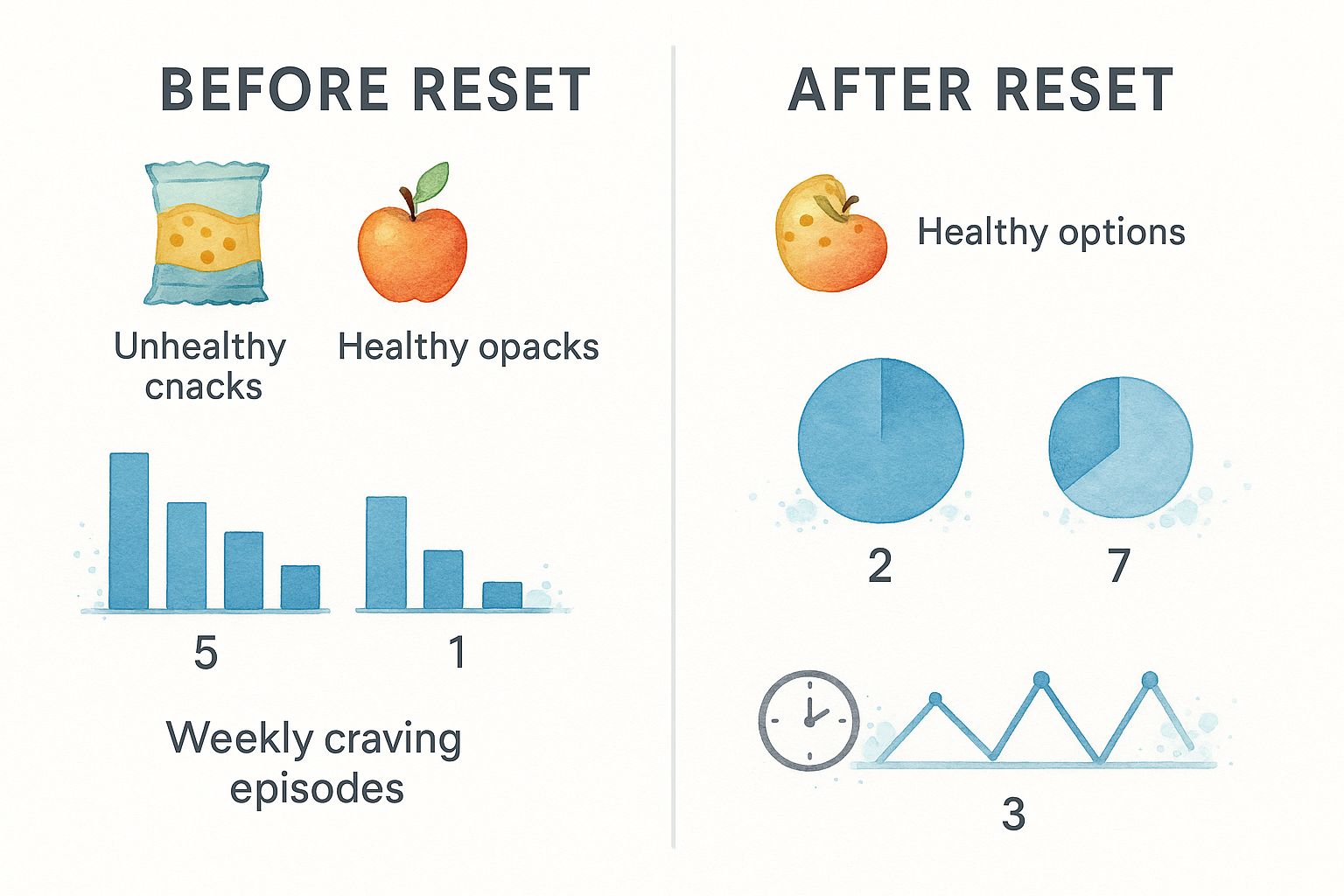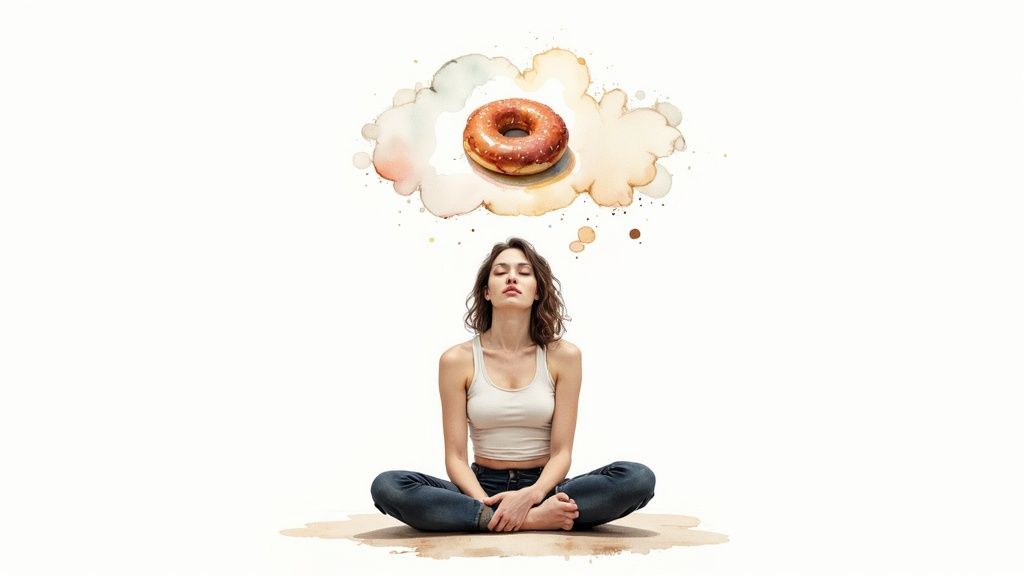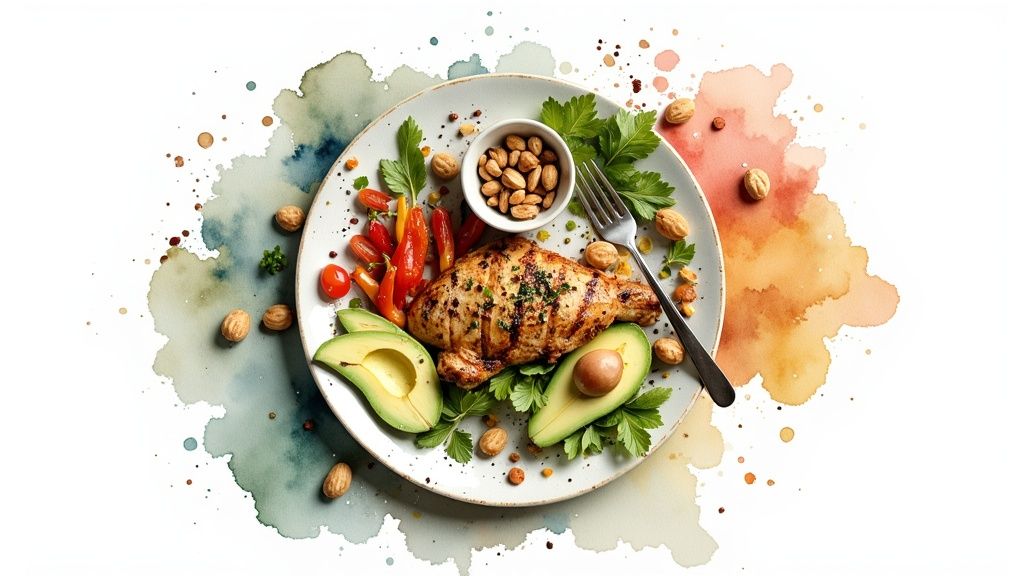If you're trying to control food cravings, the first thing to understand is that willpower is often the wrong tool for the job. It's like trying to hold back a tidal wave with a bucket. The real key is to get curious about why the cravings show up in the first place, allowing you to respond thoughtfully instead of reacting automatically. This mindset shift is the foundation for making real, lasting change.
Why You Crave Certain Foods

Ever notice how you get an intense, undeniable urge for a warm, gooey cookie, but you never seem to crave a crisp carrot stick with the same passion? That desire for a specific food is rarely about a lack of discipline. It’s actually a complex signal from your brain and body, driven by a powerful mix of psychology and physiology.
Often, these cravings are tangled up in our memories and emotions. The smell of baking bread might pull you right back to your grandmother's kitchen, making you crave not just the bread, but the feeling of comfort and nostalgia that comes with it. Or maybe a brutal day at work triggers a powerful urge for fast food—your brain has simply learned to associate that greasy bag with quick, reliable pleasure.
The Brain's Reward System
At the heart of all this is your brain's reward system. When you eat something delicious—especially foods packed with sugar, fat, and salt—your brain releases dopamine, a neurotransmitter that makes you feel pleasure and motivation. This creates a powerful feedback loop.
Your brain logs that experience, remembering that food as a surefire way to get a reward. So the next time you feel stressed, bored, or a little down, your brain sends out a signal for that same food to get another dopamine hit. This process can become so automatic that the craving feels completely overwhelming and totally separate from actual physical hunger.
"Cravings are not a sign of weakness; they are a sign that your brain's reward system is working exactly as it was designed. The challenge is that modern, ultra-processed foods can hijack this system, creating a cycle that feels difficult to break."
Understanding Your Personal Triggers
Getting a handle on your cravings starts with becoming a detective of your own patterns. You have to identify what sets you off. Once you know your triggers, you can start to dismantle their power over you.
To get started, let's look at some common craving culprits. This table breaks down typical triggers to help you pinpoint what might be happening behind the scenes for you.
Common Craving Triggers and Their Underlying Causes
| Craving Trigger | Psychological Reason | Physiological Reason |
|---|---|---|
| Stress or Anxiety | Seeking comfort or distraction from negative feelings. The food provides a temporary escape. | High cortisol levels (the stress hormone) can increase appetite and cravings for high-fat, sugary foods. |
| Boredom or Procrastination | Eating provides stimulation and a break from a tedious task. | Low energy or blood sugar dips can be misinterpreted as boredom, leading to a search for a quick energy source. |
| Visual Cues | Seeing a food commercial, a social media post, or walking past a bakery. | The sight or smell of food can trigger the release of saliva and stomach acids, preparing the body to eat. |
| Habitual Association | Always eating popcorn at the movies or having a snack while watching TV at night. | The brain creates a strong neural pathway linking the activity with the food, making the craving automatic. |
| Poor Sleep | Seeking a quick energy boost to fight fatigue. Decision-making is impaired when tired. | Lack of sleep disrupts hunger hormones (ghrelin and leptin), increasing appetite and reducing feelings of fullness. |
| Dehydration | Thirst signals can sometimes be misinterpreted by the brain as hunger signals. | The body needs fluids for metabolic processes. A mild craving might just be a sign you need water. |
By reviewing this table, you can start to see that a craving is rarely just a craving. It's your body's (sometimes clumsy) way of telling you it needs something—whether that's comfort, energy, or just a glass of water.
Research from the Harvard T.H. Chan School of Public Health shows just how powerful these patterns can become. Studies using the Yale Food Addiction Scale found that around 20% of people meet the criteria for food addiction. The most common symptom? A persistent desire or unsuccessful attempts to cut down on certain foods—usually the ultra-processed kind engineered to light up those reward centers in your brain.
By understanding these deep-seated drivers, you can finally stop fighting a battle of willpower and start addressing the real issue.
Build a Craving-Proof Environment
Trying to fight off food cravings with sheer willpower is like trying to stay dry in a downpour without an umbrella. Sooner or later, you're going to get soaked. A much smarter strategy is to change your environment so that healthy choices become the easy, default option, not a daily battle of wills.
When your surroundings are set up to support your goals, you stop draining your mental energy on resisting temptation and can save it for more important things.
This whole process starts right in your kitchen. I call it a "pantry reset"—a strategic overhaul designed to get temptations out of sight and put healthy, convenient options front and center. The real goal is to make grabbing a healthy snack easier and faster than ordering takeout.
The Pantry Reset
First things first: get rid of the foods that constantly trigger your cravings. If you find yourself thinking about that secret stash of cookies on the top shelf all day, it's time for them to go. This isn't about punishment or restriction; it's about eliminating the constant decision fatigue that wears down your resolve.
Once you’ve cleared out the main culprits, it's time to restock with appealing, ready-to-eat healthy foods.
- Make Healthy Food Obvious: Don't hide the good stuff. Keep a big bowl of fresh fruit on the counter. Put pre-cut veggies like carrots, celery, and bell peppers in clear containers at eye level in the fridge.
- Prepare for Snack Attacks: Don't wait until you're starving to figure out what to eat. Portion out nuts, seeds, or Greek yogurt into single-serving containers so they’re easy to grab on the run.
- Set Up Hydration Stations: Keep a water bottle on your desk, one in your car, and another by the couch. It’s amazing how often our brains mistake thirst for hunger.
This infographic shows just how powerful a simple pantry reset can be.

As you can see, simply changing what's easily available can cut your craving episodes in half. You're making the healthy choice the path of least resistance.
Beyond Your Kitchen
Of course, your environment extends beyond your own four walls. Social settings—think office parties, family dinners, or nights out with friends—can be minefields of triggers. While you can't always control the menu, you can control your approach.
A little planning goes a long way. Decide ahead of time what you'll eat, or better yet, bring a healthy dish to share. That way, you guarantee there's at least one satisfying option you know you can enjoy without derailing your progress.
Modifying your environment is one of the most powerful, evidence-based strategies for long-term craving management. Since most people consume 70–75% of their daily calories at home, making this space a supportive one is a critical first step.
Over time, this isn't just about avoiding temptation. By reducing your exposure to trigger foods, you actually start to weaken the conditioned craving response in your brain. You're not just hiding the cookies; you're retraining your mind. You can read the full research on how environmental cues shape our eating habits from the American Heart Association.
When you engineer your surroundings for success, you build a foundation that makes managing food cravings feel almost effortless.
Adopt a Mindful Approach to Cravings

Let’s talk about your most powerful tool for mastering food cravings. It’s not in your kitchen or your fridge—it’s your own mind. Instead of trying to fight off cravings with sheer willpower, what if you could manage them from the inside out?
This is where cognitive strategies come in. They help shift the dynamic from a constant, exhausting battle to a practice of mindful observation and intentional choice. By learning to just pause and look at the craving without immediately giving in, you break that automatic trigger-and-eat cycle.
That little pause is everything. It gives you the space to regain control and make a decision that actually aligns with your long-term goals.
Practice Urge Surfing
Here's a technique I love: urge surfing. Think of a craving like a wave in the ocean. It builds, it gets stronger, it peaks, and then… it naturally fades away. Urge surfing is all about riding that wave of desire without letting it pull you under.
You're not fighting the urge. You're not giving in. You're just acknowledging its presence and observing it with a bit of detached curiosity.
Let's say a craving for a warm, sugary donut hits you hard. Your first instinct might be to rush to the bakery or get into a mental tug-of-war, telling yourself "no, no, no." Instead, try this: find a quiet spot and just turn your attention inward for a moment.
- Notice the physical feelings: Where is this craving showing up in your body? Is it a gnawing in your stomach? Is your mouth watering? Do you feel a bit restless or fidgety?
- Observe your thoughts: What stories is your mind spinning? Maybe it’s, "You've had such a hard day, you deserve this," or the classic, "Just one bite won't hurt."
- Acknowledge without judgment: Your only job here is to watch these feelings and thoughts come and go, like clouds passing in the sky. Don't engage with them. Don't criticize yourself for having them. Just watch.
This simple process creates a little bit of distance between you and the craving. It shows you that you are not your urges. Cravings are just temporary signals, and when you observe them instead of feeding them, you prove to yourself that they eventually lose all their power.
Reframe Your Inner Monologue
The way you talk to yourself about food has a massive impact on your actions. When your internal script is all about restriction—filled with phrases like "I can't have that" or "That's off-limits"—it almost always backfires. It makes the forbidden food seem even more appealing and creates a sense of deprivation that can lead straight to a rebound binge.
This is where cognitive reframing comes in. It’s the simple but powerful practice of changing your internal script from one of restriction to one of empowerment. You are not a victim of your cravings; you are in the driver's seat of your choices.
The magic happens when you shift your inner monologue from "I can't" to "I'm choosing not to." This tiny change in language moves you from a place of powerlessness to one of complete control. It makes all the difference in how you see your own ability to manage these moments.
Let's break down how these two mindsets play out in the real world. You’ll quickly see which one actually supports your journey.
Mindful Technique vs Restrictive Mindset
| Technique | Mindful Approach | Restrictive Mindset |
|---|---|---|
| Inner Dialogue | “I’m choosing to nourish my body with something else right now.” | “I can’t have that cookie. It’s bad for me.” |
| Emotional Result | Empowerment, control, and self-respect. | Deprivation, frustration, and increased desire. |
| Behavioral Outcome | A conscious decision is made, reducing the craving’s power over time. | Often leads to an eventual binge, followed by guilt and shame. |
| Long-Term Impact | Builds mental resilience and a healthier, more flexible relationship with food. | Reinforces an all-or-nothing cycle of restriction and overindulgence. |
By adopting a mindful approach, you learn to manage cravings by working with your brain instead of against it. You begin to see those moments of intense desire not as a threat, but as an opportunity to build your mental strength and reinforce the commitment you’ve made to your own well-being.
Reprogram Your Brain with Self-Hypnosis
Beyond simply noticing your thoughts, there's a more direct way to get to the root of your cravings: self-hypnosis. Now, forget the swinging pocket watches and goofy stage tricks. Modern self-hypnosis is nothing more than a state of deep, focused relaxation.
Think about the last time you were completely lost in a good book or movie. That "zoned-in" feeling? That's the state we're talking about. When you're that relaxed, your critical, conscious mind takes a backseat. This opens up a brief window where you can communicate directly with your subconscious—the part of your brain running all your habits and emotional reactions on autopilot.
By tapping into this suggestible state, you can start to gently update the old, unhelpful "programs" that trigger your cravings and install new, supportive ones. It’s a way of teaching your brain to prefer healthier choices naturally, without a fight.
Getting Started with a Simple Session
You don’t need any special gear or a fancy setup. All it takes is 10-15 minutes of uninterrupted time and a quiet, comfortable place where you won’t be disturbed. The whole process is safe, straightforward, and you are in control the entire time.
Here’s a simple way to guide yourself through a session:
- Find Your Quiet Space: Get comfortable in a chair or lie down. Close your eyes and take three slow, deep breaths. With every exhale, just imagine your body getting heavier and sinking into the surface beneath you.
- Focus on Your Breath: Keep breathing slowly and evenly. Don't try to force anything; just notice the feeling of the air moving in and out of your lungs. If your mind starts to wander (and it will), just gently bring your focus back to your breath.
- Deepen Your Relaxation: Picture a wave of warm relaxation starting at the top of your head. Feel it slowly spreading down through your face, your neck, your shoulders, and all the way down to the tips of your toes. Let every single muscle go limp.
That's it. You’re now in a receptive state, ready to give your mind some new instructions.
The goal of self-hypnosis isn't to magically erase cravings. It’s about changing your response to them. You're teaching your subconscious that you can feel calm, in control, and satisfied without giving in to an old, unwanted habit.
Using Visualization and Positive Statements
Once you feel completely relaxed, it's time to use imagery to rewire your response to a specific craving. Let’s use late-night ice cream as an example.
- Visualize the Craving: For just a moment, picture the craving itself. See the ice cream, but imagine you're watching it on a TV screen across the room. Create a sense of calm detachment from it.
- Visualize the Positive Choice: Now, switch the channel. Vividly imagine yourself making a different, better choice. See yourself getting up, walking to the kitchen, and pouring a warm, soothing cup of herbal tea.
- Feel the Positive Emotion: This is the most critical step. As you picture yourself sipping the tea, feel the positive emotions that come with that choice. Feel proud. Feel calm. Feel satisfied. Imagine how great you'll feel waking up the next morning—refreshed and empowered.
While you're holding that positive image and feeling, repeat a few simple statements to yourself, like, "I am in control of my choices," or "I enjoy nourishing my body." It's the powerful combination of visualization and genuine feeling that makes the new programming stick.
To end the session, just count yourself up from one to five. With each number, feel yourself becoming more alert and aware. When you reach five, open your eyes, take a nice stretch, and notice how centered you feel.
With regular practice, this technique strengthens the neural pathways for your new, desired behaviors. You’ll start to notice that your automatic reaction to triggers begins to shift, making it much easier to manage cravings—not through sheer force, but through a genuinely reprogrammed mindset.
Eat to Prevent Cravings Before They Start

While learning to handle a craving in the moment is a critical skill, what if you could stop most of them from ever showing up?
The most powerful strategy is often the most proactive one. Eating in a way that keeps your body and brain satisfied from the get-go is the ultimate game-changer. This approach is all about building meals that give you steady, sustained energy, heading off the blood sugar crashes and nutrient gaps that send your brain screaming for a quick fix.
Think of it this way: you wouldn't start a long road trip without filling up the gas tank. Strategic eating is like keeping your tank comfortably full so you never end up running on fumes, forced to make a desperate decision at the first junk food exit you see. It all comes down to building a balanced plate.
The Power Trio: Protein, Fiber, and Healthy Fats
The secret to preventing cravings is surprisingly simple. It’s a combination of three key players: protein, fiber, and healthy fats.
Each one plays a unique role in promoting satiety—that feeling of fullness and satisfaction that sticks with you long after you've finished eating. When you get all three on your plate, they work together to keep hunger and cravings quiet for hours.
- Protein is the king of satiety. It takes longer for your body to digest, which helps stabilize blood sugar and prevents the sharp spikes and crashes that trigger intense sugar cravings.
- Fiber, found in fruits, vegetables, and whole grains, adds physical bulk to your meals. It slows everything down, signaling to your brain that you've had enough.
- Healthy Fats from sources like avocado, nuts, and olive oil also slow down how quickly your stomach empties. This keeps you feeling satisfied and helps your body absorb key vitamins.
A meal that’s missing one of these—like a plain bagel for breakfast—is a recipe for a mid-morning energy dive and an all-consuming craving for something sweet to get you through to lunch.
Building Craving-Proof Meals and Snacks
Putting this into practice is easier than it sounds. It’s not about restriction; it’s about smart additions. Instead of just grabbing a piece of fruit, which is mostly carbs, pair it with a little protein or fat to make it a complete, satisfying snack.
Give these simple, craving-busting combos a try:
- An apple (fiber) with a spoonful of almond butter (protein and healthy fat).
- Greek yogurt (protein) topped with berries (fiber) and a sprinkle of chia seeds (fiber and healthy fat).
- A handful of baby carrots (fiber) with a side of hummus (protein, fiber, and healthy fat).
These pairings are designed to give you lasting energy, not just a temporary rush.
"A well-balanced meal sends a clear signal of satisfaction to your brain, reducing the 'food noise' that drives compulsive snacking. You're not just filling your stomach; you're nourishing your body in a way that pre-emptively silences cravings."
Interestingly, this approach flies in the face of the old belief that dieting just makes cravings worse. A landmark study found something fascinating: when people simply ate their most craved foods less often, their desire for them actually went down—no matter the portion size. You can dive into the full findings on how consistent dietary changes can reduce food cravings from the National Institutes of Health.
This shows us that building new, balanced eating habits isn't about fighting your body. It's about retraining your brain and giving your body what it truly needs.
Got Questions About Cravings? Let's Talk.
When you start digging into the psychology of cravings, a lot of questions pop up. It's totally normal to wonder how long it will take, what to do in specific situations, and how to separate fact from the fiction you see online.
Let's clear the air and tackle some of the most common questions I hear. Getting these answers straight can make all the difference in keeping you motivated and on the right path.
"So, How Long Until These Cravings Actually Go Away?"
This is the big one, isn't it? Everyone wants to know when they'll feel free. The honest, no-fluff answer is: it's different for everyone. Your brain, your habits, your history—it's all unique.
That said, most people feel a real shift in the intensity of their cravings within a few weeks of consistent practice. The big changes, where the new, healthier choice feels almost automatic, take a bit longer.
For instance, studies on dietary shifts have shown that cravings for sweets, high-fat foods, and fast food can drop significantly within 12 weeks. Your brain simply needs time to prune those old, well-worn neural pathways and build new ones.
The trick is to stop looking for a finish line and start celebrating the small wins along the way. Patience isn't just a nice idea here; it’s a core part of the strategy. You're building something designed to last.
"Should I Avoid My Trigger Food Completely or Just Eat Less of It?"
This is a fantastic question because it gets right to the heart of how habits work. Our instinct often tells us that "everything in moderation" is the answer, but the research points to something a little different.
It turns out that reducing how often you eat a craved food is usually more powerful than just cutting down the portion size.
Think of it this way: every time you eat that cookie, you're reinforcing the habit loop in your brain. Frequency is the glue that holds a habit together. By putting more time and space between you and that trigger food, you start to weaken its psychological grip.
For some people, especially if the eating feels more compulsive, a temporary "cold turkey" approach can be a powerful way to reset the brain's reward system. For others, a small, mindfully savored portion is the better path. You might need to experiment a little, but a great place to start is by focusing on frequency.
"I Heard Cravings Mean I'm Deficient in a Vitamin. Is That True?"
You've probably heard this one before: craving chocolate means you need magnesium, or wanting a steak means you're low on iron. It sounds logical, but there’s very little science to back it up.
The truth is, cravings for a specific food are almost never a sign of a specific nutrient deficiency.
Cravings are far more likely driven by the stuff we've been talking about—emotional triggers, stress, habit loops, and your brain's powerful reward chemistry.
However, your overall nutrition does play a huge role. When your body isn't getting the nutrients it needs, it can mess with your blood sugar and energy levels. This instability can trigger intense, generalized cravings for quick-energy foods like sugar and refined carbs.
So while that chocolate craving probably isn't a direct SOS for magnesium, making sure you’re eating a balanced, nutrient-rich diet is still one of the best things you can do to keep all kinds of cravings from taking over.
Ready to stop fighting your cravings and start reprogramming your mind for lasting success? The Satisfied Health 21‑day self‑hypnosis program is designed to help you rewire subconscious patterns and build a healthier relationship with food from the inside out.
📲 Download Satisfied to start your journey tonight.